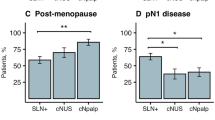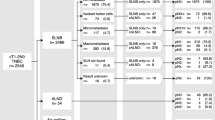Abstract
Background
Triple-negative breast cancer (TNBC) is a highly aggressive subtype of breast cancer. The purpose of this study was to determine if patients with TNBC have a higher risk of lymph node (LN) metastases.
Methods
A prospective database review identified 3,289 patients treated with a mastectomy or with breast-conserving surgery between January 2000 and May 2012. The final analysis included those patients who underwent sentinel node biopsy (SNB) and/or axillary lymph node dissection (ALND), and the following information: age at diagnosis, tumor size, grade, stage, histologic subtype, presence of lymphovascular invasion (LVI), and the status of estrogen, progesterone, and human epidermal growth factor receptor 2 (HER2).
Results
A total of 2,967 patients met the inclusion criteria. SNB was performed in 1,094 patients, ALND in 756, and both SNB and ALND in 1,117 patients. LN metastases were detected in 1,050 (35 %) patients. On univariate analysis, the LN positivity varied across subtypes with 33 % in luminal A, 42 % in luminal B, 39 % in TNBC, and 45 % in HER-2 (p = 0.0007). However, on multivariable analysis, there was no difference in LN positivity among subtypes. Age <50, grade 2 or 3 tumors, size ≥2 cm, and presence of LVI were significant predictors of LN positivity. Four or more involved nodes were observed most commonly in the HER2 (19.4 %) and luminal B (13.7 %) subtypes, but only 9.4 % in TNBC (p < 0.0001).
Conclusions
Predictors of LN metastases include younger age, higher grade, larger tumor size, and presence of LVI. Patients with TNBC are not more likely to have involved nodes than those with non-TNBC.

Similar content being viewed by others
References
Bevilacqua JLB, Kattan MW, Fey JV, Cody HS 3rd, Borgen PI, Van Zee KJ. Doctor, what are my chances of having a positive sentinel node? A validated nomogram for risk estimation. J Clin Oncol. 2007;25(24):3670–9.
Yoshihara E, Smeets A, Laenen A, et al. Predictors of axillary lymph node metastases in early breast cancer and their applicability in clinical practice. Breast. 2013;22(3):357–61.
Hwang RF, Krishnamurthy S, Hunt KK, et al. Clinicopathologic factors predicting involvement of nonsentinel axillary nodes in women with breast cancer. Ann Surg Oncol. 2003;10(3):248–54.
Perou CM, Sørlie T, Eisen MB, et al. Molecular portraits of human breast tumours. Nature. 2000;406(6797):747–52.
Van Zee KJ, Kattan MW. Validating a predictive model for presence of additional disease in the non-sentinel lymph nodes of a woman with sentinel node positive breast cancer. Ann Surg Oncol. 2007;14(8):2177–8.
Sotiriou C, Neo S-Y, McShane LM, et al. Breast cancer classification and prognosis based on gene expression profiles from a population-based study. Proc Natl Acad Sci USA. 2003;100(18):10393–8.
Dent R, Trudeau M, Pritchard KI, et al. Triple-negative breast cancer: clinical features and patterns of recurrence. Clin Cancer Res. 2007;13(15 Pt 1):4429–34.
Montagna E, Maisonneuve P, Rotmensz N, et al. Heterogeneity of triple-negative breast cancer: histologic subtyping to inform the outcome. Clin Breast Cancer. 2013;13(1):31–9.
Sørlie T, Perou CM, Tibshirani R, et al. Gene expression patterns of breast carcinomas distinguish tumor subclasses with clinical implications. Proc Natl Acad Sci USA. 2001;98(19):10869–74.
Arvold ND, Taghian AG, Niemierko A, et al. Age, breast cancer subtype approximation, and local recurrence after breast-conserving therapy. J Clin Oncol. 2011;29(29):3885–91.
Reyal F, Rouzier R, Depont-Hazelzet B, et al. The molecular subtype classification is a determinant of sentinel node positivity in early breast carcinoma. PLoS ONE. 2011;6(5):e20297.
Freedman GM, Anderson PR, Li T, Nicolaou N. Locoregional recurrence of triple-negative breast cancer after breast-conserving surgery and radiation. Cancer. 2009;115(5):946–51.
Gangi A, Chung A, Mirocha J, Liou DZ, Leong T, Giuliano AE. Breast-conserving therapy for triple-negative breast cancer. JAMA Surg. 2014;149(3):252–8.
Ragage F, Debled M, MacGrogan G, et al. Is it useful to detect lymphovascular invasion in lymph node-positive patients with primary operable breast cancer? Cancer. 2010;116(13):3093–101.
Rivadeneira DE, Simmons RM, Christos PJ, Hanna K, Daly JM, Osborne MP. Predictive factors associated with axillary lymph node metastases in T1a and T1b breast carcinomas: analysis in more than 900 patients. J Am Coll Surg. 2000;191(1):1–6; discussion 6–8.
Viale G, Zurrida S, Maiorano E, et al. Predicting the status of axillary sentinel lymph nodes in 4351 patients with invasive breast carcinoma treated in a single institution. Cancer. 2005;103(3):492–500.
Silverstein MJ, Skinner KA, Lomis TJ. Predicting axillary nodal positivity in 2282 patients with breast carcinoma. World J Surg. 2001;25(6):767–72.
Mustafa IA, Cole B, Wanebo HJ, Bland KI, Chang HR. The impact of histopathology on nodal metastases in minimal breast cancer. Arch Surg. 1997;132(4):384–90; discussion 390–1.
Harden SP, Neal AJ, Al-Nasiri N, Ashley S, Querci della Rovere G. Predicting axillary lymph node metastases in patients with T1 infiltrating ductal carcinoma of the breast. Breast. 2001;10(2):155–9.
Woo CS, Silberman H, Nakamura SK, Ye W, Sposto R, Colburn W, et al. Lymph node status combined with lymphovascular invasion creates a more powerful tool for predicting outcome in patients with invasive breast cancer. Am J Surg. 2002;184(4):337–40.
Crabb SJ, Cheang MCU, Leung S, et al. Basal breast cancer molecular subtype predicts for lower incidence of axillary lymph node metastases in primary breast cancer. Clin Breast Cancer. 2008;8(3):249–56.
Wiechmann L, Sampson M, Stempel M, et al. Presenting features of breast cancer differ by molecular subtype. Ann Surg Oncol. 2009;16(10):2705–10.
Disclosure
None.
Author information
Authors and Affiliations
Corresponding author
Rights and permissions
About this article
Cite this article
Gangi, A., Mirocha, J., Leong, T. et al. Triple-Negative Breast Cancer is Not Associated with Increased Likelihood of Nodal Metastases. Ann Surg Oncol 21, 4098–4103 (2014). https://doi.org/10.1245/s10434-014-3989-7
Received:
Published:
Issue Date:
DOI: https://doi.org/10.1245/s10434-014-3989-7




